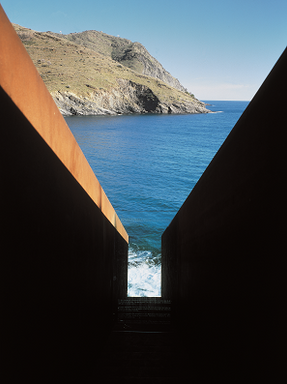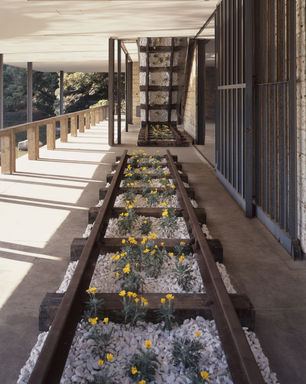
Israel Ministry of Foreign Affairs

ダニ・カラヴァン追悼 記憶の時空
2021年5月29日。イスラエル生まれの世界的な美術家ダニ・カラヴァン(1930-2021)の訃報が世界を駆け巡った。
ー水沢勉(神奈川県立近代美術館館長)
わたしは最初にドイツ語のサイトでそのニュースを知った。重要な作品をドイツ国内でも制作していることからすれば当然の反応のひとつであった。ケルンの大聖堂のすぐそばの広場をつなぐ空間全体を作品化した《マアロット》(1979-86)、ニュルンベルクのカルトゥジアン広場にある世界人権宣言の章句を刻んだ《人権の道》(1989-93)といった代表作は現在もドイツに存在するカラヴァンの代表作であり、まさに公共空間にあって多くのひとびとがそのメッセージを日々受け取りつづけている。
カラヴァンの作品は、イスラエルの砂漠の地ベエル・シェバに作りあげた《ネゲヴ記念碑》(1963-68)以来、いわゆる記念碑というスケールをはるかに越えた時空へと広がる性格のものであり、同時に、既存のものを押しのけて、そこに過剰な存在感を主張するものでもない。むしろ、隙間のような空間や、通常は無視されてしまう周囲の風の動きや音までも作品に取り込む開かれた性格を特徴とする。
のちにそれは「サイト・スペシフィック」という言葉で簡明に指示される特質であり、作品の生まれる「場」を、五感すべてを集中して生かす創作の姿勢となって、全作品を貫くことになる。世界のどこにある作品であれ、カラヴァンの作品は、訪れたとき、その場所の空間的、音響的、あるいは天球的といってもおかしくない広がりのなかで体験されることになる。しかも、それは無名のひとびとと記憶を介して呼び交わす思念をも、じつに詩的に呼び覚ますのである。
ひとを威圧する大規模なモニュメントではなく、その場に佇んだひとが、五感の覚醒を通じて、時空を越えた記憶の広がりのなかで、寛容で、平和な時空との対話を、あくまでも自分の足下、つまりいままさに踏みしめている場所のたいせつさを胸に刻みながら、静かに続ける・・・それこそがカラヴァン作品の神髄であろう。そして、それは今後、カラヴァンそのひとの思い出とも相乗することとなるだろう。
親友メナシェ・カディシュマンとのコラボレーション《カディッシュ― ツァバールのためのレクイエム》
細やかな個人的な思い出。1994年から翌年にかけての日本国内を巡回した本格的なカラヴァンの回顧展をきかっけに、イスラエルの近代と現代の美術を取りあげた二つの企画展「イスラエル美術の近代」と「イスラエル美術の現代」が、2001年にそれぞれ鎌倉の神奈川県立近代美術館の当時の本館と、埼玉県立近代美術館でほぼ同時に開催されることになった。そのときカラヴァンはさまざまな準備の段階で献身的な協力を惜しまなかった。
そして、親友のメナシェ・カディシュマンとみごとなコラボレーションを鎌倉館本館のテラスとそれに面する平家池を使って展開することになった。《カディッシュ― ツァバールのためのレクイエム》。坂倉準三設計の鎌倉館のなかでももっとも魅力的なテラスにカラヴァンは鉄路を敷設し、黄色い花の鉢をいくつもそこに配置し、さらに階段下には鏡を貼って、まるで「ヤコブの階梯」のように鉄路の反射像が垂直に上昇してゆくように設置してみせた。そして、池のなかにはイスラエルでは広く知られている南アメリカ産のサボテン「ツァバール」を立体物としてひとつ建てた。そして、その周囲にカディシュマンは、無数の死者の顔を暗示する、黄色く塗装した木製のレリーフを浮かべたのである。
じつはあらかじめファクスでやり取りして決めておいた「ツァバール」の棘の穴の大きさが美術館で用意していた小さな電球のソケット部分の大きさと異なり、うまく穴にぴったり嵌めることができなかった。そこで電球のガラス以外の部分にテーピングをほどこして少しだけ太くして、穴に合うように調整した。その結果、本来意図していた棘のすっと伸びた感じとまったく違ってしまった。
カラヴァンがそれをどう思うかとても心配だった。かれは一目見るなり笑みを浮べ「とてもいいよ。グリューネヴァルトの磔刑のキリストみたいだね」と喜んでくれた。
まだ夕暮れは開館時間前に訪れるような季節だった。夕暮れの平家家のうえに点灯するカラヴァンのサボテンは、死者の痛みを感じさせると同時に、それを癒すような慰めもわたしたちにあたえてくれたのだった。

水沢 勉 (Tsutomu Mizusawa)
神奈川県立近代美術館館長
1952年、横浜市生まれ
1976年、慶應義塾大学美学美術史学科卒業
1978年、慶應義塾大学大学院修士課程修了後、神奈川県立近代美術館学芸員として鎌倉館に勤務
2008年、横浜トリエンナーレ2008��「タイムクレヴァス」の総合ディレクター。
2011年より現職
ドイツ語圏の世紀末美術から近現代美術、日本の近現代美術とその国外との交流史など
単著『この終わりのときにも 世紀末美術と現代』思潮社、1989年
五十殿利治との共編著『モダニズム/ナショナリズム』せりか書房、2003年
Schlüsselwörter der Modernität – am Beispiel der Kunst des modernen Japan,
museum global: Mikrogeschichten einer ex-zentrischen Moderne, K20, 2019













